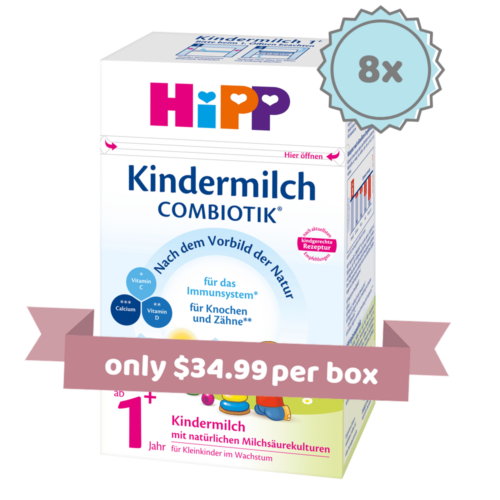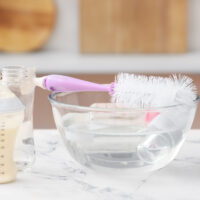A “best toddler formula” provides supplemental nutrition during the toddler years, but there are some things to consider when purchasing one: First, toddler formula is not regulated by the FDA. Second, it is not a necessity for a toddler who drinks milk and eats a variety of nutritious foods. Based on these two considerations, we have compiled a list of the nine best toddler drinks on the market.
Please note that each recommendation below is for that specific formula, not every formula sold by that brand. We are very picky, and promise to only offer the best options available on the market.
Best Toddler Formula
Baby’s Only and HiPP formulas are organic formulas compared to Gerber Good Start , Enfagrow Premium, Pure Bliss, and Similac Go & Grow which are not organic formulas.
Baby’s Only Organic Whey Protein Toddler Formula
Save money with Baby’s Only Organic Whey Protein Toddler Formula and still gain valuable nutrition for toddlers. Despite the low cost, this product includes organic ingredients.
The first ingredient is lactose, followed by whey and non-fat milk. Lactose is the naturally occurring sugar in cow’s milk, but there is also some present in breastmilk. The inclusion of whey and whey protein concentrate, layered with fats, is most similar to breastmilk. Boosting the protein content with additional whey provides an optimal composition designed for a successful transition to a new formula.
Unfortunately, the fats are not as great as the carbs and proteins. In this formula, you will find canola oil which is a controversial, processed, and cheap filler fat. This formula is non-GMO, however, which may parents prefer. Other fats include sunflower, safflower, and coconut. You will also find a long list of vitamins that are consistent with daily recommendations.
What we love about this formula is that it’s more of a supplemental beverage instead of a meal replacement drink. Use this formula to encourage nourishment without filling your toddler up on protein. Moreover, the use of specific ingredients in the correct order encourages digestion and soft stools.
Gerber Good Start Infant Formula A2 Milk
The Gerber Good Start Infant Formula A2 Milk (HMO) Non-GMO Powder Toddler Drink offers an affordable supplemental drink for toddlers. It provides A2 milk casein proteins, considered by some to be easier to digest (source). Parents can choose this when they want an alternative to normal milk for sensitive tummies.
Also, this formula offers both a probiotic in the form of L. reuteri, and a prebiotic, 2′-FL HMO, also found in breastmilk (source). Overall, this formula is designed to give sensitive stomachs a little aid while receiving additional nutrition.
Gerber goes even further by avoiding the use of GMOs and hormones in their product. They provide the recommended daily values for each of their vitamins, and it’s an extensive list. You will also find sources of both DHA and ARA to help boost the brain, along with iron and a level of calcium very similar to milk.
The sugar source is lactose instead of corn syrups or maltodextrin. Also, they use decent sources of fats, including safflower and coconut, but also include soy and palm oil. This formula is a good source of protein too with the addition of nonfat dry milk.
Enfagrow Premium Toddler Transitions Infant Formula
Consider Enfamil’s Enfagrow Premium Toddler Transitions Infant Formula only if your toddler is picky and not eating well. While the formula has many beneficial ingredients, it has one problem: the third ingredient is corn syrup solids. Yes, this may taste better, but most toddlers get plenty of sugar without it being added to the formula.
The other ingredients are fantastic. The proteins include non-fat milk and carbs lactose. Even the oils for fat are semi-decent such as coconut, sunflower, palm olein, and soy.
In this product, you will also find a prebiotic, ARA, and DHA. These help to provide immunity, and promote brain development. Moreover, the formula is non-GMO, which provides higher quality.
You will find adequate amounts of vitamins and higher levels of calcium in this product than in many toddler formulas, but no increases in iron. It also provides thirty more vitamins and minerals, serving as a multi-vitamin drink for your child. The price is nice on this formula, too, making it a decent option for toddlers who eat a limited amount of fruits, vegetables, and proteins.
Pure Bliss by Similac Toddler Drink with Probiotics
The Pure Bliss by Similac Toddler Drink with Probiotics is an almost perfect option for toddlers. Unfortunately, the product has corn maltodextrin, just like some other toddler formulas. At least with this option, this starch is lower on the list of ingredients instead of being one of the first, meaning less of it.
Also, with Pure Bliss, the formula is non-GMO, meaning the corn maltodextrin is not genetically modified. As a product of Ireland, you can expect the formula to live up to European standards while complementing the diets of toddlers between 12-36 months.
What we love about this product is that its milk is sourced from grass-fed cows that have not received growth hormones or antibiotics. Also, it’s gluten-free, halal, and kosher. The company even throws in probiotics for digestive health.
The first ingredients include nonfat milk for protein and lactose as its main carbohydrate. Next are the fats: high oleic sunflower, soy, and coconut oils.
Finally, the formula is calorie-dense with a large amount of protein. It’s high in vitamins and minerals, including both iron and calcium. Moreover, it includes DHA and ARA for brain health.
Go & Grow by Similac Toddler Drink
If you asked us if Similac made the best infant formulas, we would say “no.” But, when it comes to the toddler options, they offer a better product. The Go & Grow by Similac Plus 2′-FL HMO Toddler Drink avoids corn syrups and maltodextrin while providing vitamins and minerals for picky children. Moreover, this toddler drink provides 2′-FL HMO, a prebiotic found in breastmilk that supports the immune system.
With Go & Grow, your toddler also gets DHA, lutein, and vitamin E to support brain, eye, and cell development. Even better, the sugars come from cow’s milk lactose, which offers carbohydrates in a natural manner, unlike added corn syrup or maltodextrin. Also, while this formula (and most infant and toddler formulas) uses some less than ideal oils for fat content, this one does offer a healthy option, coconut oil.
The only real issue with this formula is its high sugar (15%) and low protein content. What’s nice about the lack of protein, however, is your toddler will not fill up on formula. This will leave room for solid foods like fruits, vegetables, meats, and whole grains. Furthermore, this formula is not calorie-dense, so it can serve as a supplement.
Lastly, the drink is non-GMO, but we don’t have amounts for the 25 vitamins and minerals. It also offers a significantly higher amount of calcium and lower amounts of iron than infant formula. Talk to your doctor to see if this amount of calcium or iron is necessary for your child.
A more economical version is the Go & Grow by Similac. It has the same composition as the Go & Grow Plus 2′-FL HMO by Similac, except it does not contain DHA, lutein, and vitamin E.
HiPP 1+ Years Combiotic Organic Childrens Milk

With HiPP 1+ Years Combiotic Organic Childrens Milk, you get a German toddler formula ready to deliver high-quality and nourishing ingredients. The price is a little higher, but that’s because it comes from overseas with European organic certification. Use this formula from one year and up as a drink or even prepare with cereal.
The powder has a long shelf life. Also, it’s free of starch, maltodextrin, gluten, soy, and corn syrup! This is why so many parents buy toddler formula from Europe. Moreover, they avoid GMOs, antibiotics, hormones, artificial, and synthetic ingredients. We love that they avoid added sugars in any form, so toddlers get nutrition from the formula, and sugar only from solid food sources.
Hipp formula stage four promotes better digestion for toddlers and is modeled as much as possible like breast milk. The main ingredients include skimmed milk for protein and lactose for carbohydrates. Next, you get oils including palm (from an organic source), rapeseed, and sunflower.
The formula also includes a probiotic, prebiotics, omega 3 & 6, and age-appropriate amounts of calcium, vitamin C, and vitamin D. This product has a limited amount of iron, so you will need to make sure your child gets additional iron from food sources. Otherwise, you get a long list of vitamins and minerals for a healthy toddler.
Best Organic Toddler Formula
Similac Organic Toddler Drink with A2 Milk
Some studies show that A2 Milk may be better for babies, toddlers, or adults for that matter, so theSimilac Organic Toddler Drink with A2 Milk is a fantastic drink mix for toddlers. Current research suggests that A2 milk is easier to digest, and causes less inflammation of the intestines (source). This is ideal for little bellies. However, what we like about this formula is the excellent ingredient list, starting with organic ingredients.
Whether or not organic ingredients are important is subjective, but theyoften suggests high quality that should be paramount for infants and toddlers. Furthermore, the Similac Organic Toddler Drink with A2 Milk avoids GMOs and even palm olein oil, which can block calcium absorption (source).
A negative aspect of this formula is that it includes added sugars, with a whopping total sugar of 24%! Since most toddlers tend to get plenty of sugar from solid food sources, milk, and juice, it’s best to reduce sugar options when possible, including their toddler drink. The primary ingredients are lactose, nonfat milk, and safer oils to nourish toddlers. It’s higher in fats than many other toddler options, which is good since they need healthy fat for brain growth (source).
The formula provides helpful ingredients like DHA, lutein, and vitamin E to help with the growth of the brain, eyes, and immunity. However, this organic formula offers less calcium than cow’s milk. Moreover, the company does not provide the full amounts of vitamins and minerals, as they are not regulated, but do include a significant amount of iron and potassium.
Best Goat Milk Toddler Formula
Kabrita Goat Milk Toddler Formula
With the Kabrita Goat Milk Toddler Formula, you don’t get a “normal” formula, but instead one made from goat’s milk. Why goat’s milk? Because it’s easier to digest, nutrient-dense, full of fatty acids, and gut-healthy prebiotics (source).
Think about it. The purpose of cow milk is for an 80-pound calf to grow into a young cow that weighs about 600 pounds. Meanwhile, a baby goat weighs just 10 to 12 pounds which is similar to a human baby. Adult goats weigh between 44 to 310 pounds, making them more equivalent to the weight of a human.
If your toddler struggled with cow’s milk-based formula as an infant and continues to have difficulty, goat’s milk formula might be a suitable alternative. The proteins are easier to digest as they contain more casein than whey. This is similar to breastmilk which contains only casein. Goat’s milk, however, is not a recommended alternative in the presence of a cow’s milk protein allergy. Children who do not react well to the proteins in cow’s milk may encounter the same problem with goat milk.
There is no guarantee, however, that your child will like the smell or taste! Cow’s milk is definitely more suited to the American palate. This formula is made in the Netherlands without GMOs, however, and comes with a mild flavor that many children may prefer.
This goat milk formula provides only natural lactose sugars and healthy fats along with prebiotics. As for vitamins, the formula reads like a vitamin supplement, with a massive list of 22 essentials. Honestly, the only problem might be the palmitic acid and soybean oils,, found in many formulas and are almost unavoidable.
Best Plant-Based Toddler Formula
Else Plant-Based Complete Nutrition Formula for Toddlers
While the Else Plant-Based Complete Nutrition Formula for Toddlers is not our first choice, it’s a necessary option for those with allergies. This formula does not use any milk products, it’s an invaluable choice for picky children. It can also be used in other foods such as pancakes and smoothies.
Keep in mind that not every toddler will like its almond milk flavor, or not be willing to try the drink. It is equivalent in price to some of the European toddler formulas, but more expensive than others due to the kinds of ingredients used. A great benefit is that it is much lower in sugar, and definitely worth a try, especially for families who prefer a non-dairy option. Not only is it dairy-free, but also free of gluten, GMOs, soy, and peanuts.
Furthermore, the formula is organic, vegan, and kosher with all the right certificates. The main ingredients are almond butter for fat and protein, buckwheat flour as a carbohydrate and protein, and tapioca maltodextrin as a binder. Do not worry about this type of maltodextrin as it’s not even remotely as sweet as that made from corn.
From there, you have a list of vitamins and minerals. However, this option does not include a probiotic or prebiotic. Your child still gets a large amount of calcium and iron, despite the lack of dairy products, and it provides balanced nutrition.
How Toddler Formulas Compare
The table below compares only the recommended products on this page. A low or high Price means it is low or high compared to the other products listed. The Popularity Score reflects how often readers click on and buy the product. The Quality Score is our assessment of the overall performance and satisfaction with the product compared to others in the table.
Buying Criteria for Toddler Formula
Regulation
Remember though, toddler formulas are not regulated by the FDA or any other organization. Moreover, the American Academy of Pediatrics and most medical experts prefer that toddlers drink cow’s milk, and do not recommend toddler formula (source). After their first birthday, toddlers should be getting most of their nutrition from food sources, and not from beverages.
No matter what fluidss you offer your toddler – milk, breastmilk, or formula – they should never drink as much as did as infants. The only exception is water; all kids over one year should have water on demand.
If you do choose to give your child other beverages, serve them in a sippy cup to help them drink less of it. Also, with juice, dilute it with water to reduce the amount of sugar and sweetness. Do not give more than four ounces of juice per day, and avoid drinks that are not 100% juice (source).
With milk, toddlers can have two to three cups per day. However, most of their hydration should be from water. Always offer water first for quenching thirst.
Ingredients
The main ingredients in toddler formula (or toddler drinks) have some similarities to those in infant formula, but with greater amounts of vitamins to promote growth. All formulas include a combination of protein, fats, carbohydrates, vitamins, and minerals. Some formulas offer a better mixture and quality of these ingredients.
However, many toddler drinks include added sugars which they do not need. Several options on this list include added sugars, usually lactose, as the first ingredient. Other well-marketed formulas did not make this list because of their even higher sugar content.
While companies market toddler formula as transitional, most of the nutrients your child needs come from breastmilk, milk, and food. Focus on a diet high in unprocessed foods and drinks for optimal health for your toddler.
Toddler Formula vs. Milk
Toddler milk is a gimmick created by formula companies to prey on parents’ concern for their children in order to sell products. Most experts feel it is unnecessary. Except in cases of a cow’s milk protein allergy or family plant-based diet preferences, milk is preferable as it’s high in calcium and protein.
Milk contains 149 calories in one cup with 88 percent water. Moreover, it contains 12.3 grams of sugar, 8 grams of fat, and 11.7 grams of carbohydrates. Cow’s milk also provides decent amounts of vitamin B12, calcium, riboflavin, phosphorus, and a host of other vitamins along with fortified vitamin D (source).
Along with a healthy diet, whole cow’s milk provides healthy fats and vitamins for one to two-year-olds. Lower fat milk is a sufficient protein source for older toddlers and children (source). Also, it’s the option most recommended by doctors and other experts. If your toddler has a normal diet and is healthy, milk is the best option.
FAQs – Toddler Formula
Can I give my toddler infant formula?
When your formula-fed child turns a year old, you should switch to milk. Infant formula is not designed to provide the nutrition a toddler needs, and should not be given to toddlers. Talk to your doctor if your child has special dietary issues or needs to determine the best option in your situation.
My toddler is a picky eater; should I offer toddler milk to make sure he/she gets vitamins?
Most toddlers are inherently “picky.” They are not as hungry as infants and don’t need to eat as much or as often to maintain a healthy weight and height. Some toddlers will eat a good amount at breakfast, lunch, and snack time, but have no appetite for dinner. Others will only “graze” or eat several small snacks throughout the day. For the majority of “picky” toddlers, you do not need to consider toddler formula as your child will obtain nutrients from food. If you are concerned, schedule an appointment with the pediatrician to discuss other ways to ensure that your child eats a healthy diet. Keep introducing new and healthy foods, and your child will get the necessary nutrients without the need for expensive formulas.
Will my toddler like the taste of toddler formula?
Toddlers who drank formula as infants may be more likely to tolerate the taste of toddler formula. However, children who were breastfed will probably not be willing to take toddler formula. Moreover, tots who have tried cow’s milk or other beverages may not like toddler formula as milk tastes so much better (to most people).













